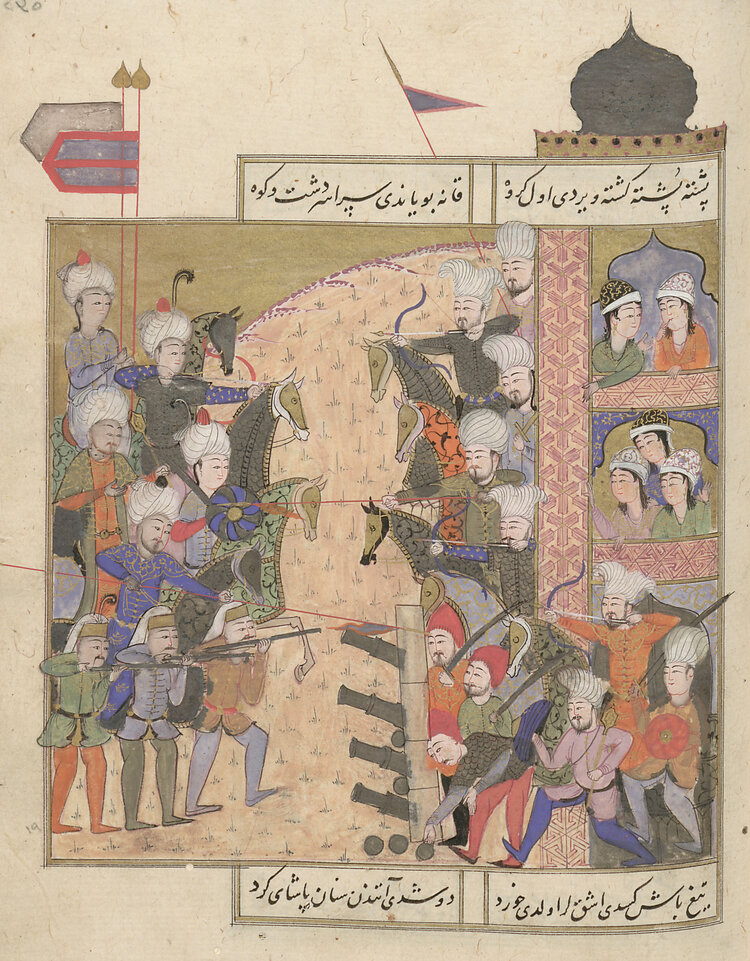Illustration from Topkapi Sarayi Museum, MS. Hazine 1597-8
Selīm-nāma by Şūkrī-i Bitlisī
f.235a. Ottomans Besieging Revolting Mamluks in Damascus in 1521

A larger image of Ottomans Besieging Revolting Mamluks in Damascus in 1521. 'Selīm-nāma', TSM Hazine 1597-8, c.1521-24.
Image source: The Ottomans and Sultan Selim I: Alan Mikhail (1517)
Previous: f231b. Ottomans battle Mamluk Arab cavalry
Next: f254a. The port of Alexandria during the Egyptian Expedition.
Back to Ottoman Illustrations of Costume and Soldiers in the Selīm-nāma by Şūkrī-i Bitlisī, c.1521-24
Referenced on p.45, The Mamluks - 1250-1517 by David Nicolle:
Here, in an Ottoman manuscript painted five years after the event, the Ottomans attack Mamluk Damascus in 1516 [sic].
The cavalry of both sides are similarly equipped, although the mamluks on the right have different and more varied turbans.
Three typical Janissary handgunners fire from the left, while three mamluks with their zamt hats operate cannon in the centre.
One of these gunners also wears a mail shirt, as do two mamluk horse-archers. (Topkapi Lib., Ms. Haz. 15978, f.235r)
Referenced as figure 13 in Sultans with Horns: The Political Significance of Headgear in the Mamluk Empire by Albrecht Fuess
Ottomans besieging the Mamluks in Damascus. "Selīm-nāma," ca. 1521-24, Istanbul Topkapi Sarayi Museum MS H. 1597-8, fol. 235r.
Photo from: Julian Raby, Venice, Dürer and the Oriental Mode (London: Sotheby Publications, 1982), 50.
(The difference in the style of headgear between Ottomans and Mamluks can clearly be noticed.)
p.83 After the Ottoman conquest it was apparently difficult for the Mamluks to give
up their specific dress and with it most of their former exclusive social status.
After learning of the death of the Ottoman sultan Selim in 926/1520, the Ottoman governor of Damascus, al-Ghazali, a former Mamluk, revolted immediately.
“And then the governor entered the Citadel and the Circassian dress appeared once again: the takhfīfāt and kallawtāt.
The wearing of Ottoman turbans and kaftans was abolished,” reports the contemporary author Ibn Ṭūlūn65
Nevertheless, the time of the old hats was definitely over, and the revolt was crushed only three months after it started in Ṣafar 927/February 1521.
The bare heads of al-Ghazali and his companions were cut off and sent to Istanbul66 (fig. 13).
65 Ibn Ṭūlūn (d. 953/1546), Mufākahat al-Khillān fī Ḥawādith al-Zamān, ed. Muḥammad Muṣṭafá (Cairo, 1964), 124.
66 Ibn Iyās, Badāʾiʿ, 5:382.
Other Illustrations of Ottoman Janissaries
Egyptian Illustrations of Costume and Soldiers

